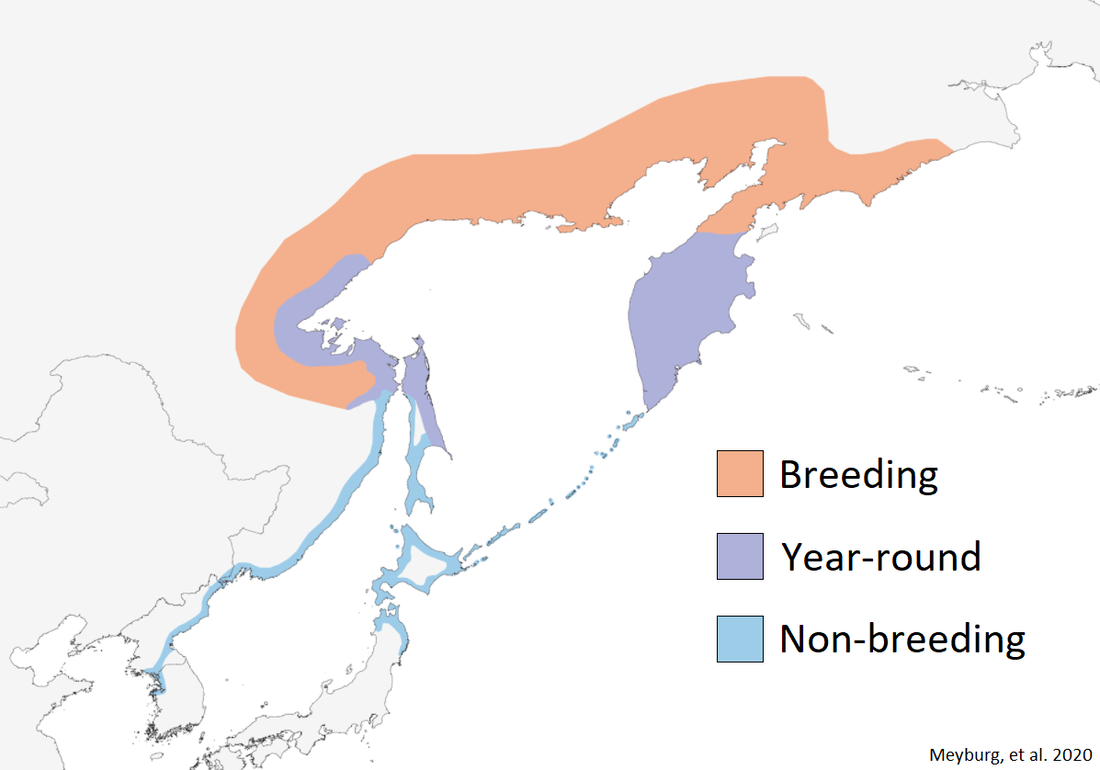Date of Last PVA/B&T Plan |
Current Population Size (N) |
Current Number of Participating AZA Member Institutions |
Projected % GD at 100 years or 10 generations** |
SSP Program Designation |
5 year target Population size |
Space Needed (Target Population size minus current space) |
Recent 5 year Population Trend (increasing, decreasing, or stable |
USFWS IUCN CITES |
Jan 2017 |
28 (15.12.1) |
12 (+2 non-AZA) |
n/a* |
Red SSP |
Value |
Value |
Increasing |
CITES: Appendix II IUCN: Vulnerable FWS: N/A |
-
Natural History
-
SSP
-
Organizations
<
>
Range & DistributionSteller’s Sea-eagles breed on the Kamchatka peninsula, the coastal area around the Sea of Okhotsk, the lower reaches of the Amur river (south to the Gorin river) and on northern Sakhalin and Shantar, Russia. A few hundred winter in Kamchatka, the northern Sea of Japan, and the coast of Okhotsk, but most winter in the southern Kuril Islands and Hokkaido, Japan. It is an uncommon winter visitor to north-eastern China, North Korea and South Korea. The fall migration typically commences in October with birds arriving in Japan in November. Adults return to their breeding territories in March and April while juveniles remain on the wintering grounds until May and sometimes June.
|
IUCN StatusVulnerable
ConservationAs of 2012, the global population of the Steller’s Sea-eagle was estimated to be between 4,600 and 5,100, including 1,830-1,900 breeding pairs. The International Union for Conservation of Nature considers the Steller’s Sea-eagle “Vulnerable” due to moderate population decline caused primarily by habitat conversion in its breeding grounds, and from mortality caused by lead poisoning while overwintering in inland Japan. They are legally protected in Russia, Japan, China and South Korea.
DietThe Steller’s Sea-eagle feeds primarily on fish, especially salmonids, taken alive or dead. They are also opportunistic and versatile as both scavengers and predators. A variety of birds and mammals are taken when primary prey species are scarce and seabirds are an important food source for certain populations and pairs.
HabitatSeldom seen far from water, the Steller’s Sea-eagle is typically found along coastlines and coastal lagoons as well as inland on large lakes and in forested river valleys (mostly on lower stretches) up to an elevation of 1,000 meters. They require tall trees or high cliffs for nesting. During winter, eagles that remain in Russia typically forage along the coast and those rivers that remain open. Eagles that overwinter in Japan stay near fresh water or move into mountainous regions to feed on deer carcasses.
|
Reproduction
Steller’s Sea-eagles begin breeding in late April and early May with considerable variation dependent upon climate and availability of food. Solitary nesters, each pair builds a massive stick nest (up to 2.5 meters wide and 4 meters deep) high in a tree or on a cliff to which they will return year after year. The clutch size is 1-3 eggs (typically 2) and incubation lasts 38-45 days. Young eagles fledge at approximately 70 days but remain dependent upon their parents for 2-3 months post-fledge. A pair of eagles will typically fledge only one young in a season although two or even three is possible when food is plentiful. Recent research indicates that eagles nesting on the coast are significantly more productive than those nesting inland, enough so that they may effectively serve as source and sink populations respectively.
Characteristics
Adult Steller’s Sea-eagles are dark brown overall with white forehead, shoulders, thighs and tail and heavy, yellow feet and beak. The tail is strongly wedged. Plumage is identical between sexes. A dark morph (formerly described as subspecies H. p. niger) lacks all white patches except for the tail. Juvenile Steller’s Sea-eagles are brown with light streaking throughout and progress through four or five intermediate plumages before attaining adult coloration. One of the largest eagles in the World, the larger females weigh between 6.2 and 9.5 kilograms with an average length of one meter and a wingspan of up to 2.5 meters. Males weigh between 4.9 and 6.8 kilograms with an average length of 0.89 meters.

Population Analysis & Breeding and Transfer Plan
Steller’s Sea-eagle (Haliaeetus pelagicus) AZA Species Survival Plan® Red Program |

Studbook
Steller’s Sea-eagle (Haliaeetus pelagicus) AZA Species Survival Plan® Red Program |
Officers
|
Name
|
Organization
|
Position
|
|
San Diego Zoo
Woodland Park Zoo |
SSP Program Leader & Studbook
Education Advisor |


